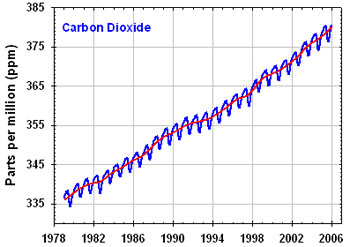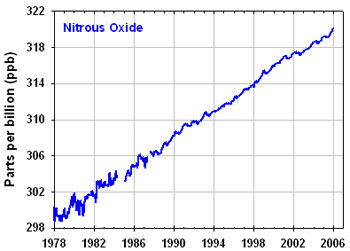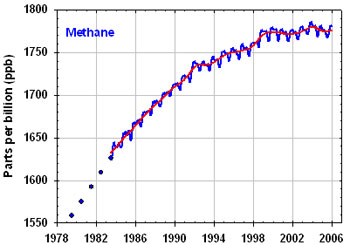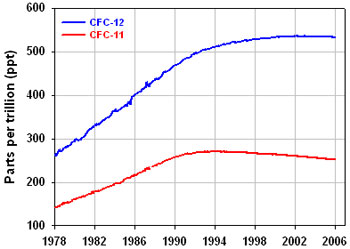Greenhouse gases hit record in 2005
mongabay.com
May 1, 2006
Levels of gases believed to be fueling global warming continued to climb in 2005 according to analysis released by the U.S. National Oceanic and Atmospheric Administration (NOAA).
The agency said its index of greenhouse gases — the Annual Greenhouse Gas Index or AGGI — showed an increase in carbon dioxide (CO2) and nitrous oxide but a leveling off of methane, and a decline in two chlorofluorocarbons (CFCs), gases that contribute to the hole in the ozone layer above Antarctica. NOAA reports that overall, the AGGI “shows a continuing, steady rise in the amount of heat-trapping gases in the atmosphere.”
The index is referenced to a baseline value of 1.00 for the greenhouse gas levels that were present in the atmosphere in 1990. In 2005, the AGGI stood at 1.215, or 21.5 percent higher than 1990. The index reflects increasing concentrations of gases that trap heat in Earth’s atmosphere. NOAA said that most of the increase is due to rising CO2, which now accounts for about 62 percent of the radiative warming caused by all long-lived greenhouse gases.
   
Global averages of the concentrations of the major, well-mixed, long-lived greenhouse gases, carbon dioxide, methane, nitrous oxide, CFC-12 and CFC-11 from the NOAA global flask sampling network since 1978. These gases account for about 97% of the direct radiative forcing by long-lived greenhouse gases since 1750. The remaining 3% is contributed by an assortment of 10 minor halogen gases, mainly HCFC-22, CFC-113 and CCl4. Methane data prior to 1983 are annual averages from Etheridge et al. (1998), adjusted to the NOAA calibration scale (Dlugokencky et al., 2005). |
|
In 2005 the agency’s index stood at 378.9 parts per million (ppm), a slight increase over 2004 when CO2 levels averaged 376.8 ppm. In a statement, NOAA explained that the 2.1 ppm increase “means that for every one million air molecules there were slightly more than two new CO2 molecules in the atmosphere.” Pre industrial carbon dioxide levels are estimated to have been approximately 278 ppm, indicating that CO2 concentrations have increased by more than 36 percent since then. Research into Antarctic ice cores published last November indicates that carbon dioxide levels are presently 27 percent higher than at any point in the last 650,000 years.
The Intergovernmental Panel on Climate Change (IPCC), a U.N. body charged with studying climate change, projects that atmospheric carbon-dioxide levels could reach 450-550 ppm by 2050, possibly resulting in higher temperatures and rising sea levels, along with a myriad of potential impacts ranging from increased storm and hurricane intensity; melting of polar ice, Arctic permafrost, and glaciers; changes in ocean currents including the Gulf Stream; increased coral bleaching and mortality of reef ecosystems; changes in ecosystems; species migration and mass extinction, especially among cold climate species; heightened danger from human pollutants like ozone; health impacts including the spread of tropical disease into cooler climates and range expansion of other pathogens; and water shortages.
The NOAA announcement comes two weeks after the Environmental Protection Agency released figures showing U.S. greenhouse gas emissions hit record levels in 2004. Greenhouse gases, which result from fossil fuel combustion and deforestation, are seen by most scientists as the principle force behind global warming.
Last week at a meeting of meteorologists in California, scientists said that last year’s record storm and hurricane season was likely the result of increased global temperatures. They warned that the intensity of storms will likely increase in the future.